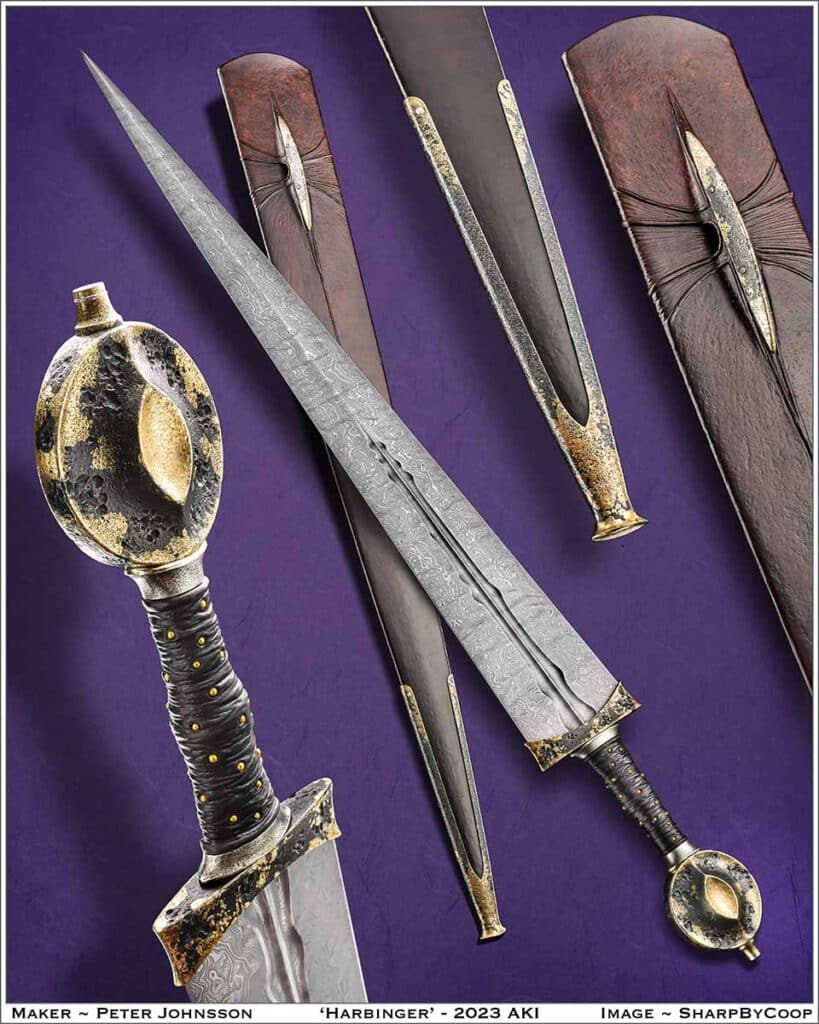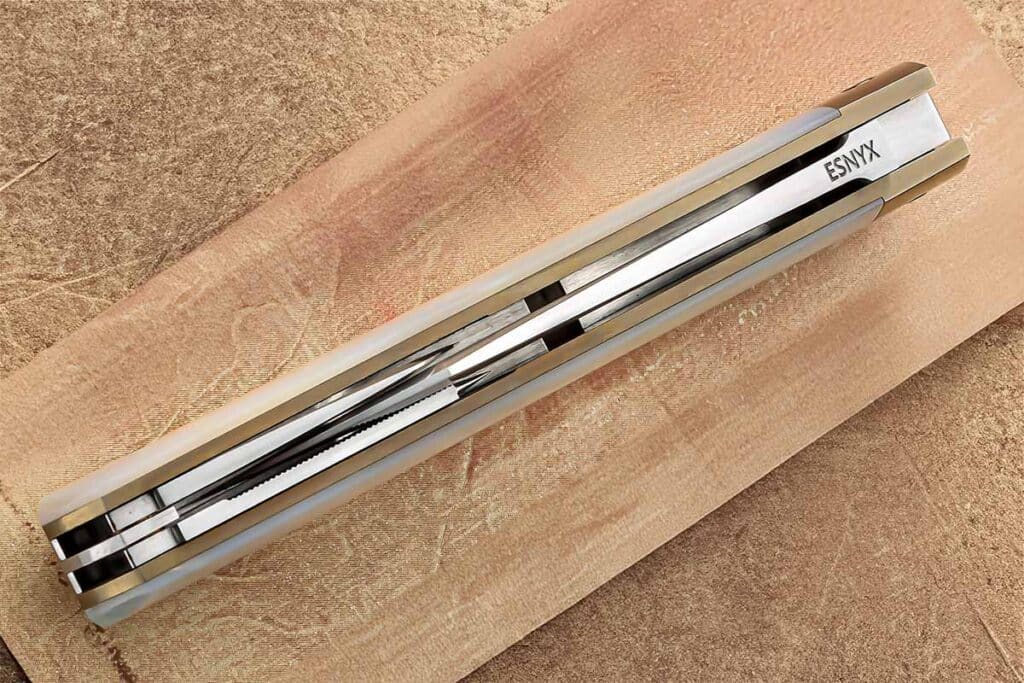
Know some of the criteria judges use to evaluate custom knives.
Artistic impression, technical merit, fit and finish, walk and talk: What are the standards and where are the attributes that lead to a judge’s conclusion when awards are on the line at a custom knife show? It goes without saying that sometimes the difference between a winner and runner-up is as thin as the edge of a sharpened blade.
Those who judge knife competitions are obviously obliged to employ their experience, skill, years of involvement with the industry and discerning subjectivity. As a result, looking at the criteria that some veteran judges employ helps observers develop a deeper perspective on the competition among the best custom makers in the business. Moreover, if you’re a collector, knowing what judges look for should help you improve your collection; if you’re a knifemaker, it should help you make better knives—or at least knives that are more likely to win judging competitions.

“I use the four F’s,” advised longtime purveyor Les Robertson, “fit, finish, flow and function. Fit is the overall look of the knife, focusing on how well the guard/bolster fits the blade and guard. How well does the material fit up against the guard and spacers? If a full tang or tapered tang, how well does the handle material fit to the tang?” When it comes to finish, Les primarily looks for consistency and degree of difficulty.
“No matter what type of finish, is it consistent from the tip to the end of the knife? It can have no spots, scratches or other inconsistencies,” he explained. “The degree of difficulty comes in the form of the type of finish. A mirror finish is much more complex than a tumble or bead blast finish. I give bonus points for two-tone finishes, such as a mirror finish on the hollow of the blade and satin for the flat of the blade.”
Finishing up with flow and function, Robertson commented, “Flow—does the knife transition smoothly from one end to the other? Sometimes art knives become more about the art. The embellishments can take away from the basic design the knife was built on. Function: will the knife do what the design intended it to do? While there is always room for improvement on standard designs, the maker should temper the changes and base them on reality. Often, the design borders on or moves into the fantasy realm.”
Robertson adds that the first thing he notices when judging is whether the knife fits the category entered. Hunters, for instance, do not generally feature 10-inch bowie-style blades. Common errors or flaws, he observes, can usually be found in grind line symmetry in the choil area, whether a folder or fixed blade.
Complexity
Jared Oeser has been a custom knifemaker for 13 years and finds himself most familiar with folders. “Folders tend to be, more often than not, the more complicated knives to make,” he began. “Fit and finish are big factors, especially on a folder, and every detail has to be taken into account along with how hard the knife is to make. Adding a lockback feature or multiple blades makes the knife more complicated, and I have seen knives win in categories—even best in show—that might have a tiny flaw but win on the sheer complexity of the knife, just how hard it was to make.”
Oeser likes to take a broad view in the beginning, looking over each of the knives in a particular competition and moving from there. “In a process of elimination, I take some away and then give an overview of the ones that stand out with their level of detail, refinement and craftsmanship,” he said. “I try to leave style aside because everybody has a style of their own. But I do want to see that they have accomplished what they intended to do within their own style. It may not be to my taste, but if they have nailed it, that’s great! What does the entire package look like?”

After judging for the first time at BLADE Show Texas in 2022, Jared has seen some entries that immediately fall out of contention. “There are automatic disqualifications if knives have massive flaws,” he related. “I was judging a competition with [ABS master smith] Jim Rodebaugh once, and there was a big bowie with the nut on the end of the pommel way off center. Jim put that knife down and said, ‘Well, that’s out.’”
Scale & Proportion
Scale and proportion are critical elements in the overall presentation of a custom knife, and these ideals apply to both fixed blades and folders, according to Jim Berkenfield of Forged in Thread, an apparel company that contributes revenues back to the knife industry. “I typically examine a knife from the tip of the blade to the handle,” he said, “but that’s just me. Right away your eye will pick up on common errors such as disproportionate size between blade and handle, major flaws in fit and finish, or any sort of material or structural flaw. In my opinion, line and flow are extremely important in both fixed blades and folders, yet as in most judging this is a subjective characteristic of a knife. Really, it’s no different than admiring a fine piece of sculpture or artwork and saying ‘I like that’ or ‘I don’t like that.’”
Fit and finish factor into the award-winning formula in virtually every judge’s point of view. Visual appeal and quality construction go hand in hand. “That’s extremely important in judging knives,” Berkenfield added, “because judges are always looking for perfection in whatever the category may be. Smooth transitions between materials, perfectly centered blades, and smooth locking mechanisms are all vital characteristics of a winning knife.

“In categories that I have judged, the judging teams quickly have been able to reduce the submissions to the top one, two or three knives almost at a glance. Occasionally a piece can be overlooked by a judge based upon the fact that it’s a knife that doesn’t fit [his/her] general aesthetic or knowledge set, and therefore [he/she has] a hard time appreciating it. Obviously, this is one of the reasons that judging is done by a panel and not by an individual judge.”
When it comes down to a pair of high-quality knives, Berkenfield seeks a closer examination of each piece, sometimes with a magnifying glass if necessary. Bad welds and asymmetry in damascus steel can make or break a winning knife.
“A piece of advice I have given to a lot of aspiring and up-and-coming makers is to try and find a way to distinguish your work from the multitude of other incredible knifemakers out there,” Jim concluded. “I tell them to imagine a table with 100 knives on it and one of their knives somewhere in the mix. They should be able to quickly scan the table and identify their knife from all the others. This is easier said than done and sometimes is accomplished with a completely unique design or simply by a small detail that identifies a knife as their own.”
Half The Equation
After making custom knives for eight years, Pennsylvanian Jim Vandeveld sees the judging aspect of his involvement weighted heavily on fit and finish, and his perspective on the topic is pretty specific. “Fit and finish are absolutely critical, and honestly, to me encompass more than 50 percent of a knife’s virtue,” he explained. “Polishing, edge breaking, hand satining, etching, buffing, etc., all must flow just as the design must flow. Inspecting it is purely visual and deficiencies are often glaringly obvious. For me, light usually tells the story. How a finished surface catches the light will often show most imperfections.”

For Vandeveld, the judging experience begins at first sight—literally. “I think the way the knife is perceived visually at a distance is very important,” he commented. “I personally look for balance, flow and symmetry. These are broad spectrum visual cues that tend to draw me in to take a closer look at a piece. When judging a knife, all views must be taken into account. Lateral, top down, down the point, and more, all propose a different perspective and opportunity for detail to be found or missed. The same is true for folding knives.”
Vandeveld’s judging eye gravitates toward high quality, but common and recurring errors in the knifemaking process do surface. “I think the most common flaws that pop up within custom knives tend to be both visual—related to plunge and grind symmetry as well as faceting on handles and other components, straight-line fit-ups as far as gaps and locations, finishing with etching, sandblasting and polishing—as well as ergonomic hot spots and unbroken edges. These tend to be more subjective based on the maker’s style, but when judging a knife, how it fits in the hand is just as important as the aesthetic in my opinion.”
Set Of Standards
Most judges would probably agree that the devil—or the delight—is in the details when it comes to evaluating the entries in a custom knife competition. It’s way more than a beauty contest. Accessories such as sheaths or pocket clips are not necessarily required. As more than one judge has said, “I’m judging the knife and not the sheath.”
The sheer weight of the knife may even come into play for some, while others make it only a minor consideration. Walk and talk in folding knives certainly demonstrates the proficiency of the folder maker’s tolerances, centerline and spacing, and ease of opening. The list goes on.
One thing is certain—in judging the merits of a custom knife, an experienced individual learns to apply a set of standards to which all makers aspire.
More On Knifemaking:
- D.I.Y. POWER HAMMER: DO YOU REALLY NEED ONE?
- STAINLESS DAMASCUS: CHALLENGES IN FORGING
- STROPPING: WHAT IT IS AND HOW IT’S ACCOMPLISHED
- DIY ENGRAVING VISE OR BLOCK
 NEXT STEP: Download Your Free KNIFE GUIDE Issue of BLADE Magazine
NEXT STEP: Download Your Free KNIFE GUIDE Issue of BLADE Magazine
BLADE’s annual Knife Guide Issue features the newest knives and sharpeners, plus knife and axe reviews, knife sheaths, kit knives and a Knife Industry Directory.Get your FREE digital PDF instant download of the annual Knife Guide. No, really! We will email it to you right now when you subscribe to the BLADE email newsletter.






